Simulation Study on Vertical Deformation of CRTS III Slab Track under Ambient Temperature and Its Upgrade to “Green Maintenance”
Abstract
:1. Introduction
1.1. Motivation
1.2. Review of Current Research
2. Temperature Field Fitting and Simulation of CRTS III Slab Track
2.1. Temperature Field Fitting
2.2. Simulation Analysis of CRTS III Slab Track Deformation
3. Verification of CRTS III Slab Track Deformation Simulation Model
4. Discussion and Future Works
Author Contributions
Funding
Institutional Review Board Statement
Informed Consent Statement
Data Availability Statement
Conflicts of Interest
References
- Yang, C.; Wu, C.L.; Liu, D.Y. The illumination of Tokaido Shinkansen for China’s high-speed rail development. Planners 2016, 32, 136–141. [Google Scholar]
- Gao, Q.; Zhou, C. Contrasted analysis of the comprehensive performances of CRTS series ballastless tracks on high-speed railway. J. Shandong Agric. Univ. Nat. Sci. 2019, 50, 236–239. [Google Scholar]
- Schindler, A.K.; Ruiz, J.M.; Rasmussen, R.O.; Chang, G.K.; Wathne, L.G. Concrete pavement temperature prediction and case studies with the FHWA HIPERPAV models. Cem. Concr. Compos. 2004, 26, 463–471. [Google Scholar] [CrossRef]
- Potgieter, C.; Gamble, W. Nonlinear temperature distributions in bridges at different locations in the United State. PCI J. 1989, 34, 81–103. [Google Scholar] [CrossRef]
- Kehlbeck, F.; Liu, X.F. The Influence of Solar Radiation on the Bridge Structure; China Railway Publishing House: Beijing, China, 1981. [Google Scholar]
- Zheng, Y.X.; Cai, Y.C.; Zhang, Y.M. Study on temperature prediction model of asphalt concrete pavement. Adv. Mat. Res. 2011, 243–249, 506–509. [Google Scholar] [CrossRef]
- Wu, J.X. Characteristics and temperature test technology of CRTS II ballastless track on bridge. Chin. Overseas Archit. 2015, 3, 138–140. [Google Scholar]
- Sun, Z.J.; Wang, Z.P.; Wang, J.; Kang, W.X.; Liu, X.Y. Temperature analysis of CRTS II slab ballastless track in extremely hot weather. Railw. Stand. Des. 2018, 62, 64–68. [Google Scholar]
- Wu, B.; Liu, C.; Zeng, Z.P.; Wei, W. Research on the temperature field characteristic of CRTS II slab ballastless. J. Railw. Eng. Soc. 2016, 33, 29–33. [Google Scholar]
- Liu, Y.; Chen, P.; Zhao, G.T. Study on characteristics of early temperature field of CRTS II slab ballastless track structure. China Railw. Sci. 2014, 35, 1–6. [Google Scholar]
- Liu, Y. Study on Characteristics and Influences of CRTS II Slab Track Early Temperature Field. Ph.D. Thesis, Southwest Jiaotong University, Chengdu, China, 2013. [Google Scholar]
- Barber, E.S. Calculation of maximum pavement temperatures from weather reports. Highw. Res. Board Bull. 1957, 168, 1–8. [Google Scholar]
- Williamson, R.H. Effects of environment on pavement temperatures. In Proceedings of the 3rd International Conference on Structural Design of Asphalt Pavements, London, UK, 1–4 September 1972; pp. 144–158. [Google Scholar]
- Hall, F.L.; Barrow, D. Effect of weather and the relationship between flow and occupancy on freeways. Transp. Res. Rec. 1988, 1194, 55–63. [Google Scholar]
- Robertson, W.D. Determining the winter design temperature for asphalt pavement. In Proceedings of the Asphalt Paving Technology 1997, Salt Lake City, UT, USA, 17–19 March 1997; pp. 312–343. [Google Scholar]
- Huber, G.A. Weather Database for the Superpave (Trademark) Mix Design System; National Research Council: Washington, DC, USA, 1994; Volume 2, p. 143. [Google Scholar]
- Mohseni, A.; Symons, M. Improved AC pavement temperature models from LTPP seasonal data. In Proceedings of the Transportation Research Board 77th Annual Meeting, Washington, DC, USA, 11–15 January 1998; pp. 71–72. [Google Scholar]
- Kennedy, T.W.; Huber, G.A.; Harrigan, E.T.; Cominsky, R.J.; Hughes, C.S. Superior Performing Asphalt Pavements (Superpave): The Product of the SHRP Asphalt Research Program; National Research Council: Washington, DC, USA, 1994; pp. 150–156. [Google Scholar]
- Liu, X.Y.; Zhao, P.R.; Yang, R.S.; Wang, P. Theory and Method of Ballastless Track Design for Passenger Dedicated Line; Southwest Jiaotong University Press: Chengdu, China, 2010. [Google Scholar]
- Yang, J.J.; Zhang, N.; Gao, M.M.; Sun, J.L. Temperature warping and its impact on train-track dynamic response of CRTS II ballastless track. Eng. Mech. 2016, 33, 210–217. [Google Scholar]
- Yang, J.J. Temperature Deformation of CRTS II Track Slab and Its Impact on Dynamic Response of Vehicle-Track-Bridge System. Ph.D. Thesis, Beijing Jiaotong University, Beijing, China, 2017. [Google Scholar]
- Wei, J.; Ban, X.; Dong, R.Z. Analysis of effects and damage of CRTS II ballastless track structure system induced by temperature. J. Wuhan Univ. Technol. 2012, 34, 80–85. [Google Scholar]
- Ban, X. Analysis of the Performance of CRTS II Slab Ballastless Track Structure under Temperature. Master’s Thesis, Central South University, Changsha, China, 2012. [Google Scholar]
- Yi, T.B.; Zhao, Q.J.; Xiao, W. Analysis of temperature deformation and stress value of CRTS I track slab on Harbin-Dalian passenger dedicated line. Railw. Stand. Des. 2012, 5, 37–40. [Google Scholar]
- Zhao, Y.; Si, D.L.; Jiang, Z.Q.; Wang, J.J.; Li, H. Study on temperature field and deformation of CRTS I slab-type ballastless track in severe cold area. Railw. Eng. 2016, 05, 47–52. [Google Scholar]
- Wen, Z. Application Tutorial of Fluent Fluid Calculation; Tsinghua University Press: Beijing, China, 2009. [Google Scholar]
- Tan, X. Study on Mechanical and Deformation Characteristics of CRTS III Slab Ballastless Track under Complicated Temperature. Master’s Thesis, Beijing Jiaotong University, Beijing, China, 2018. [Google Scholar]
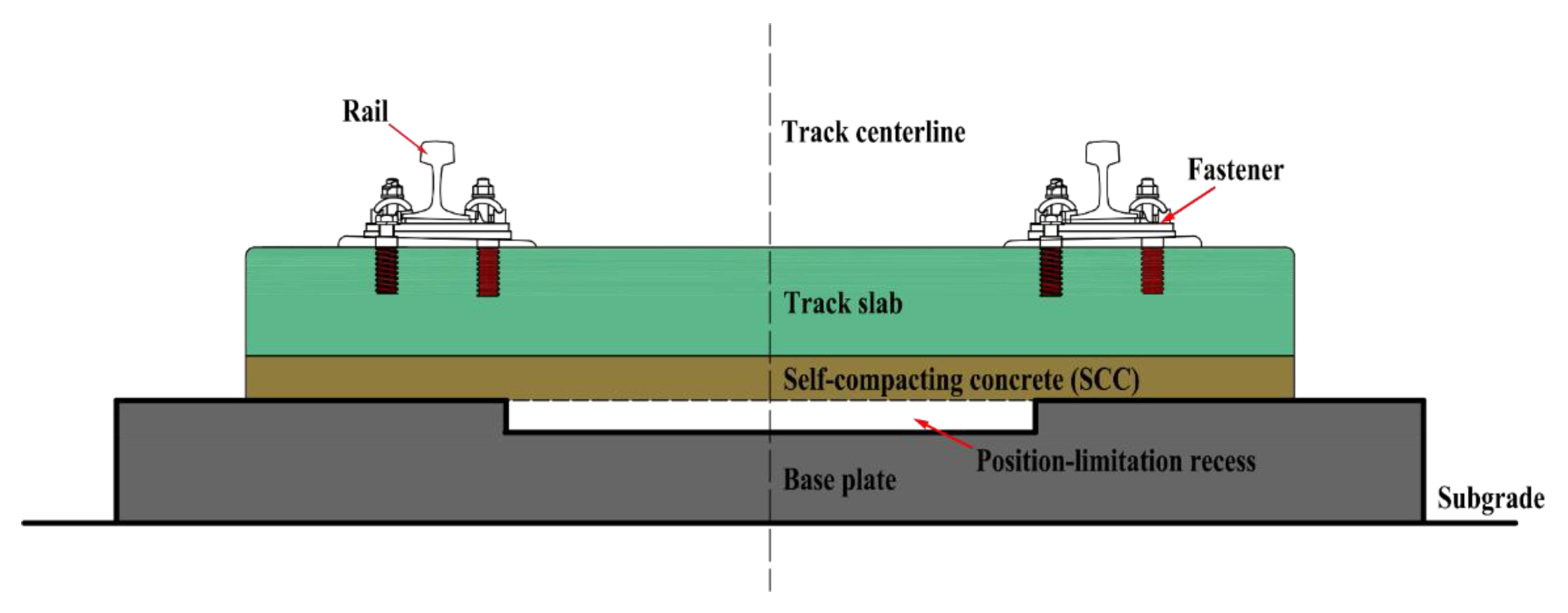
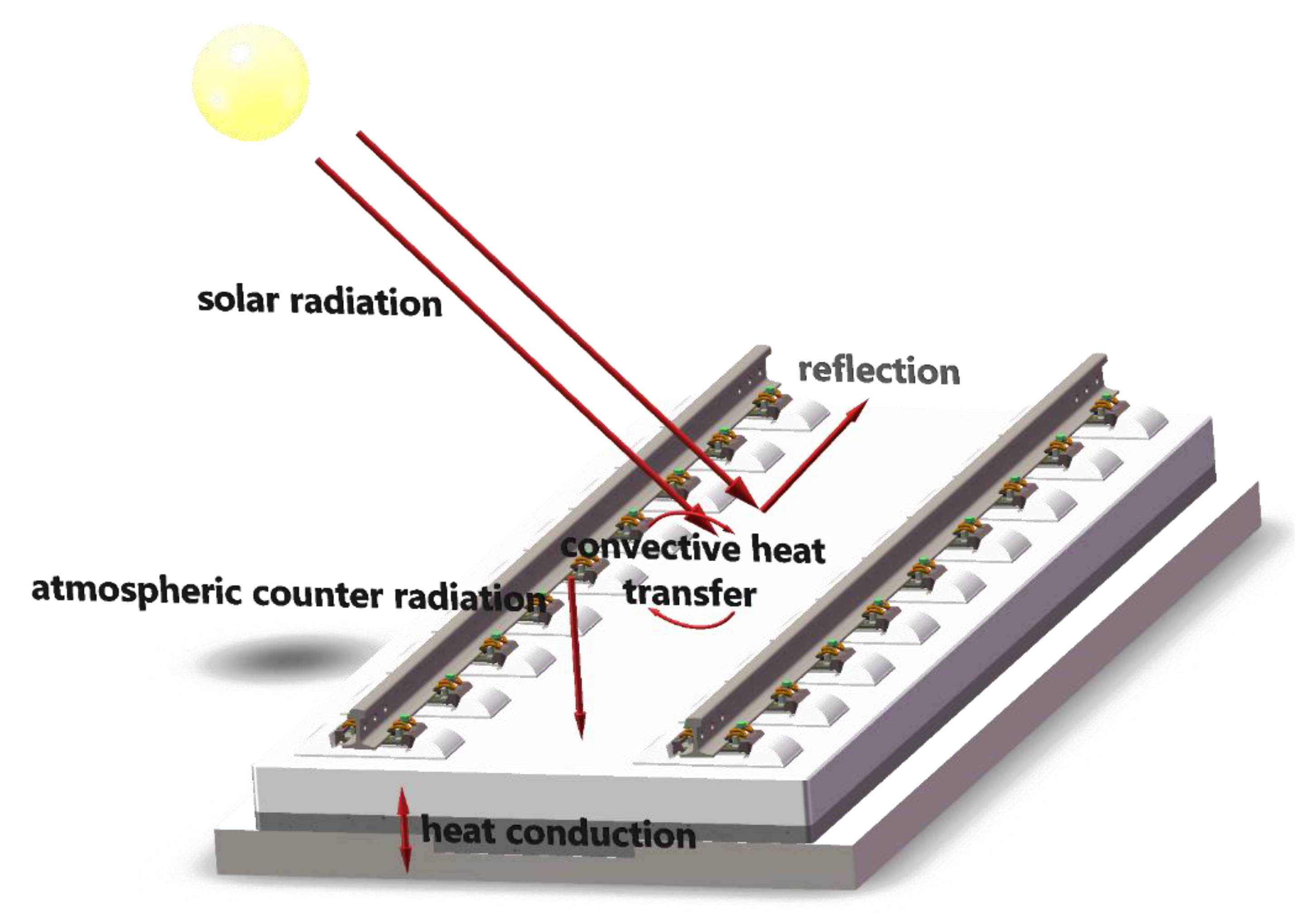
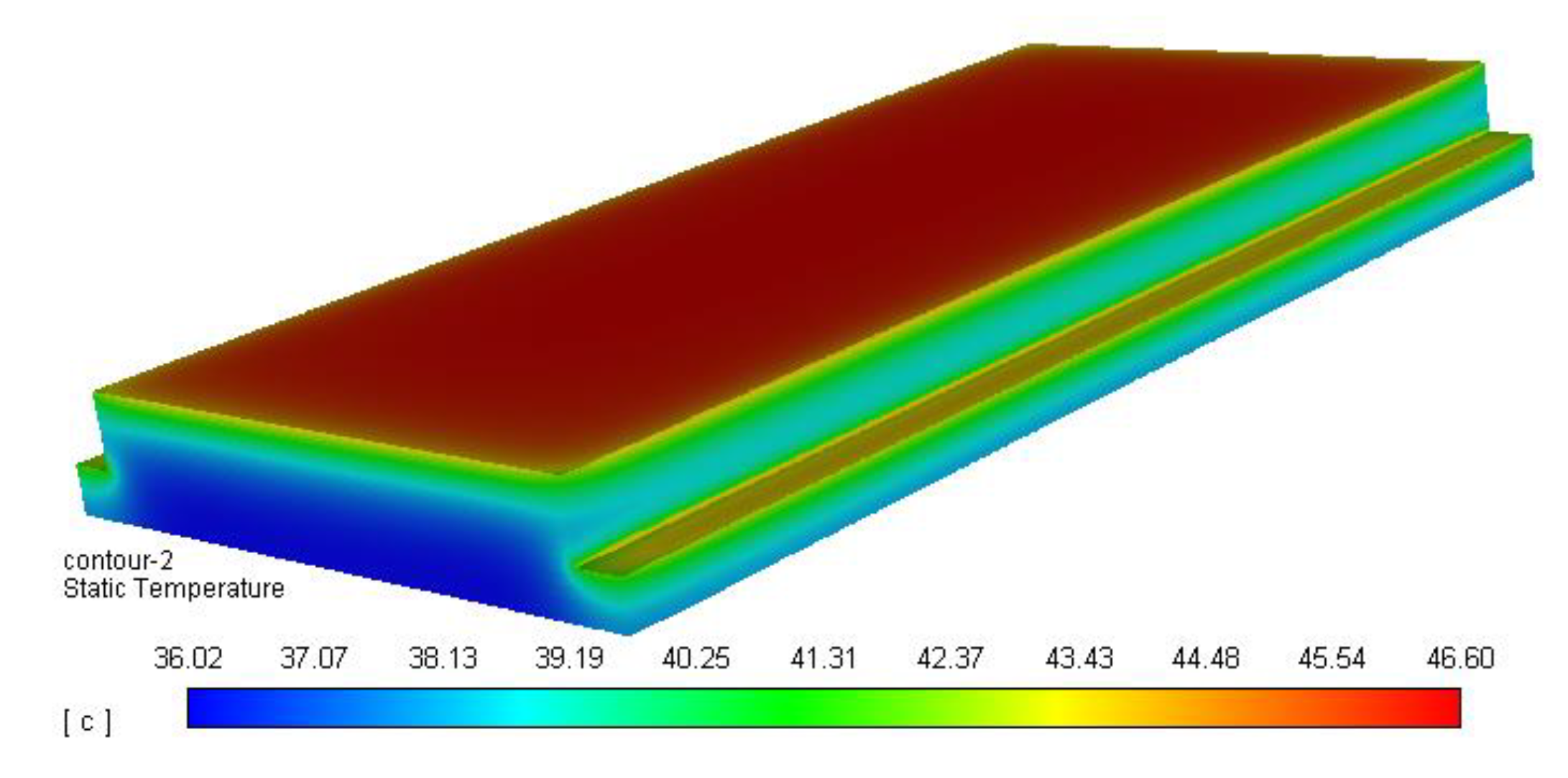
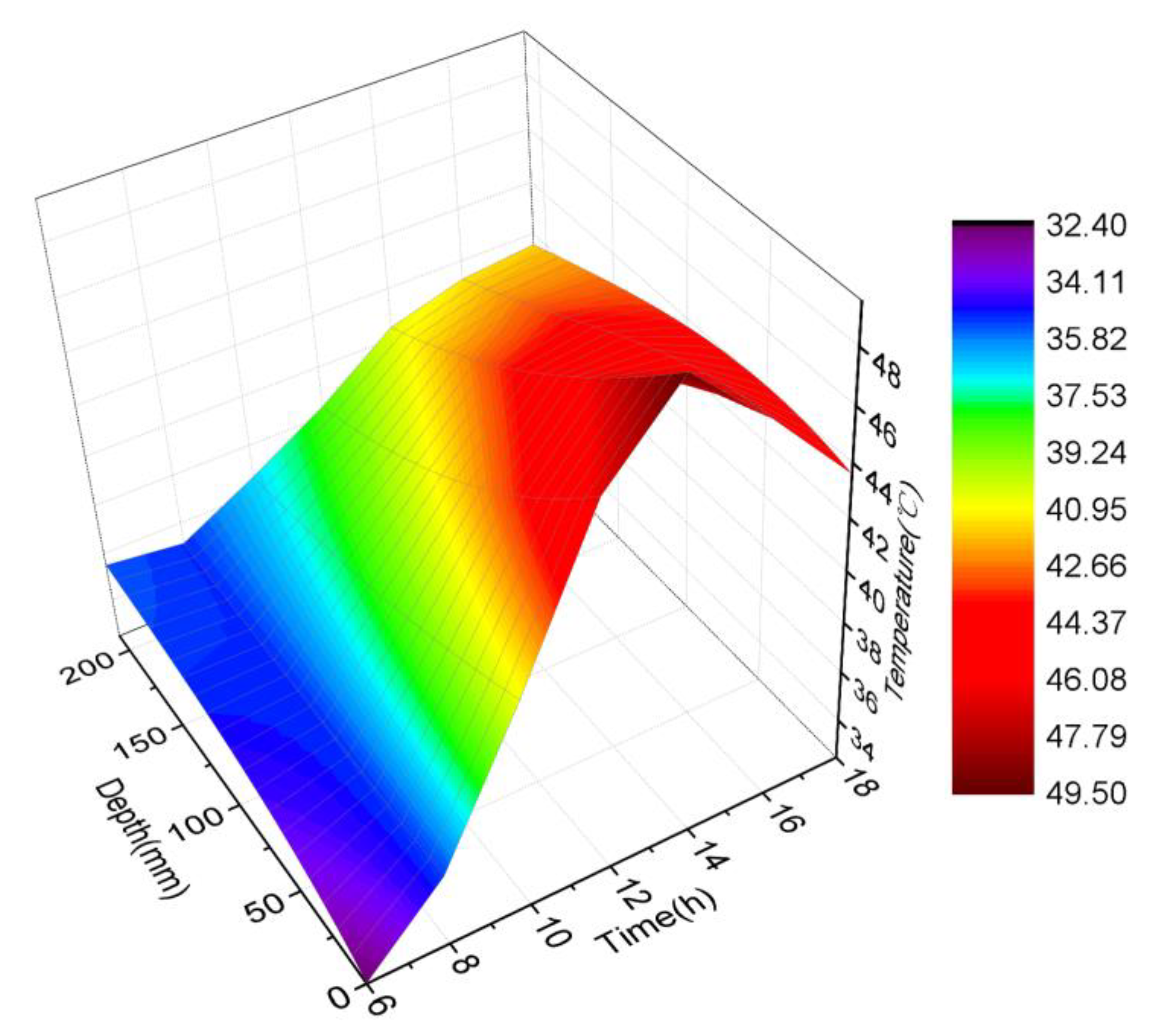
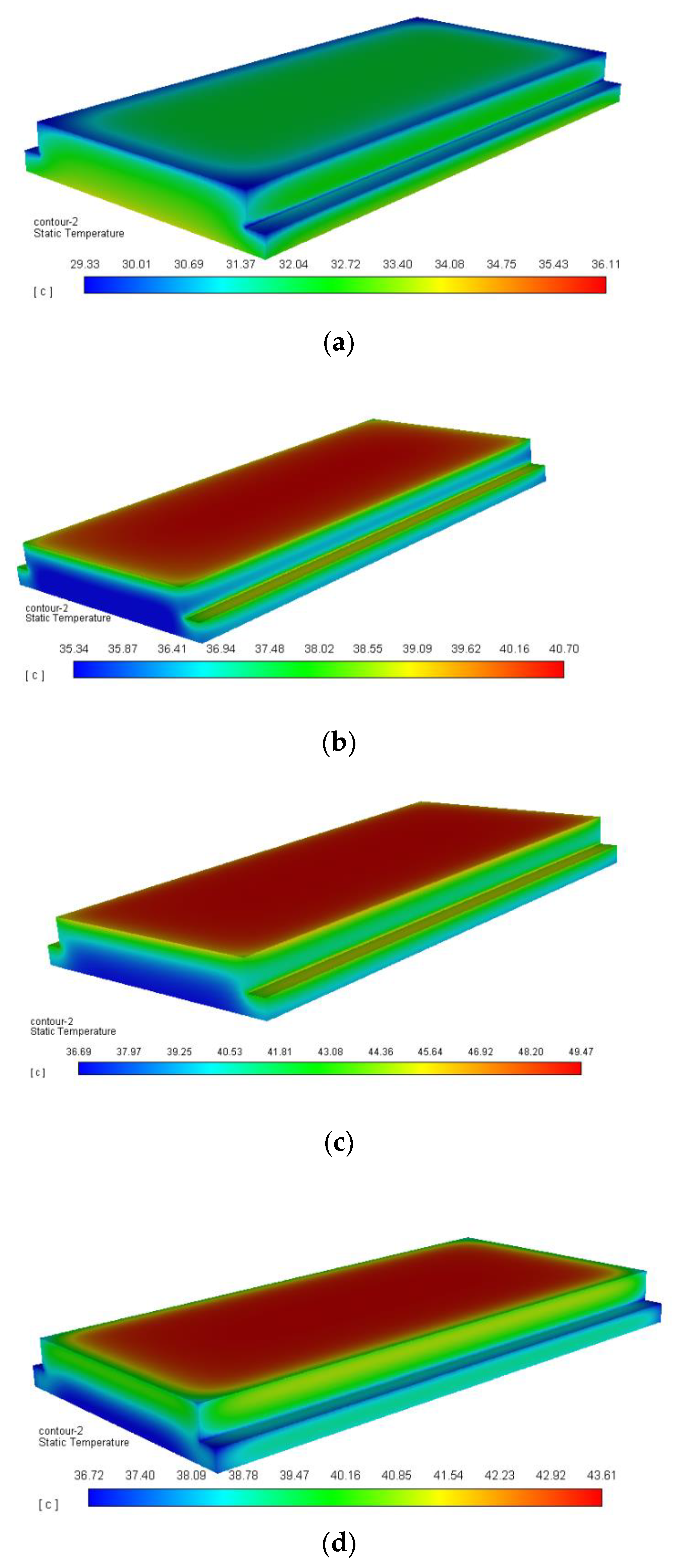

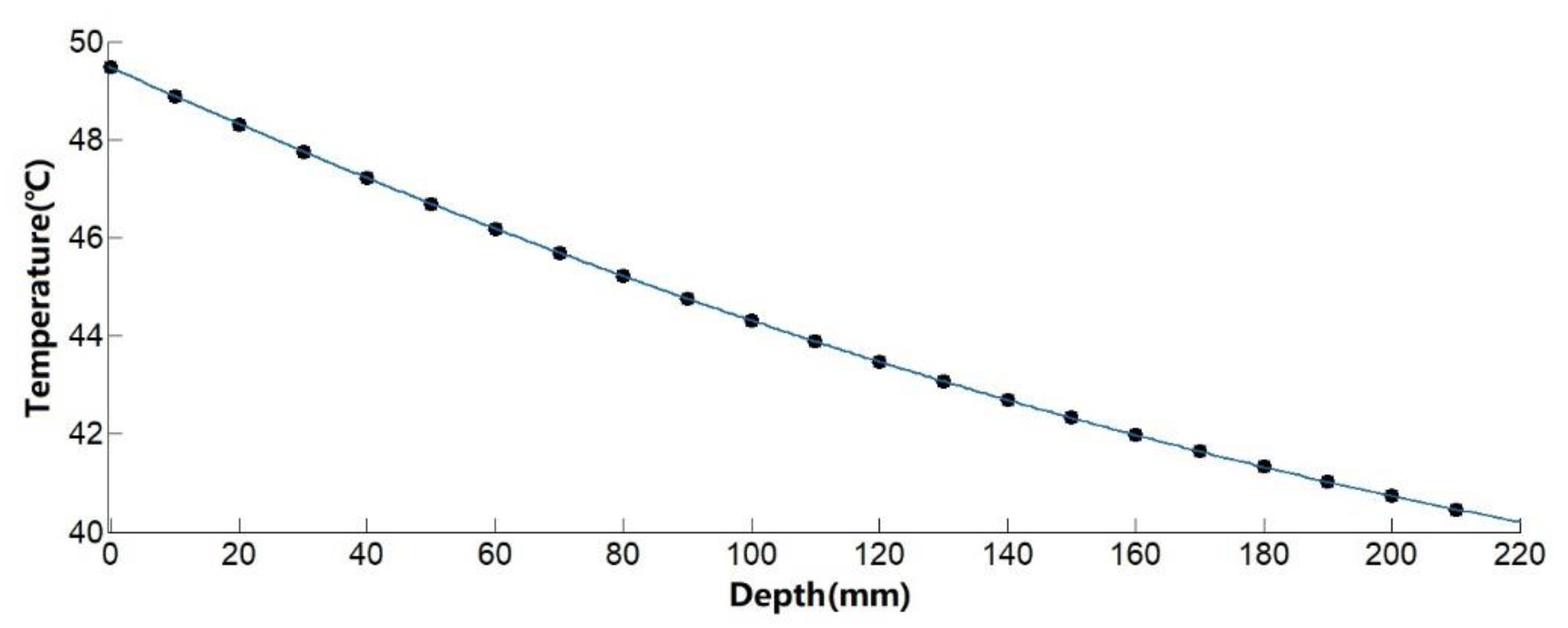
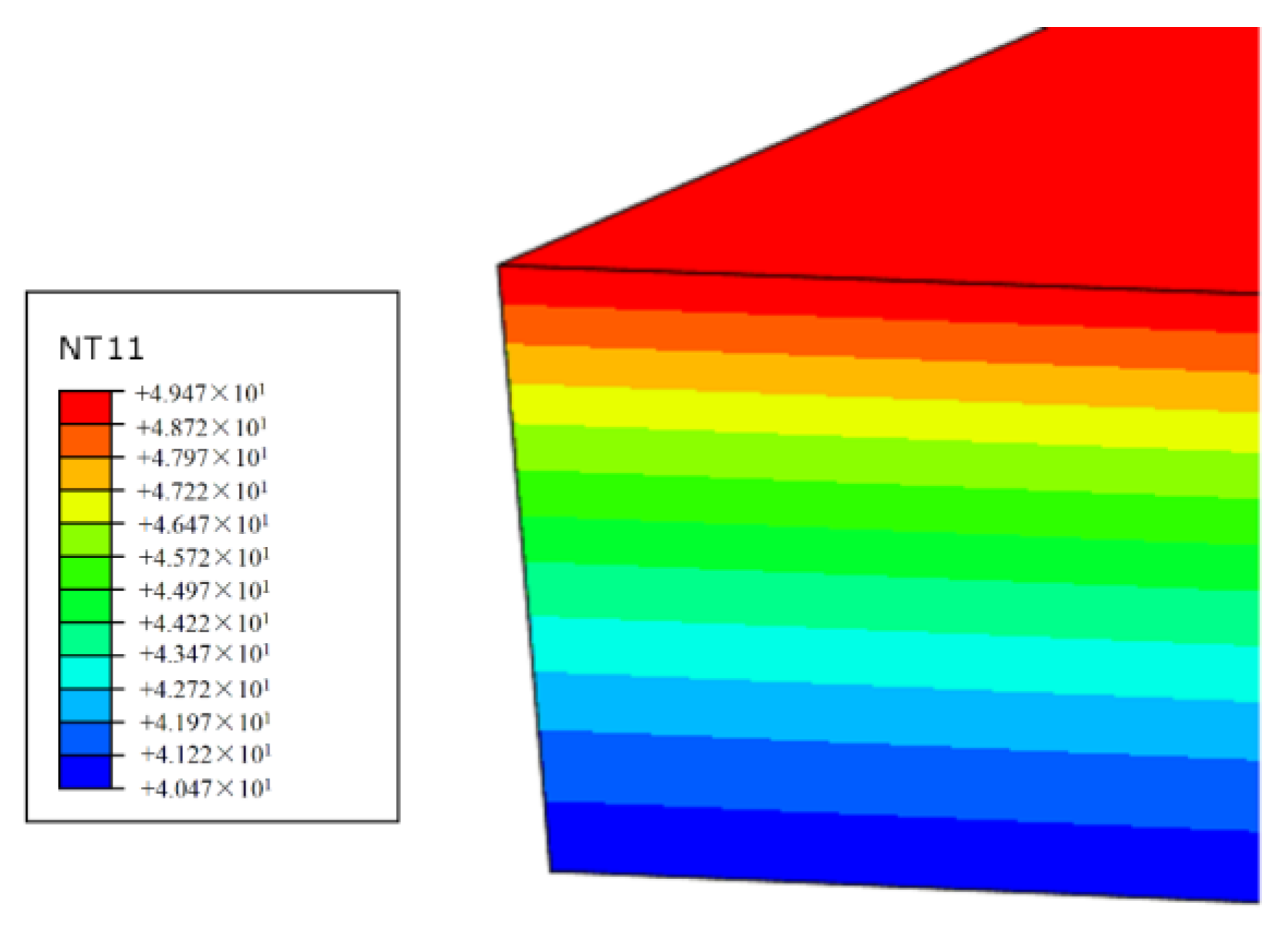
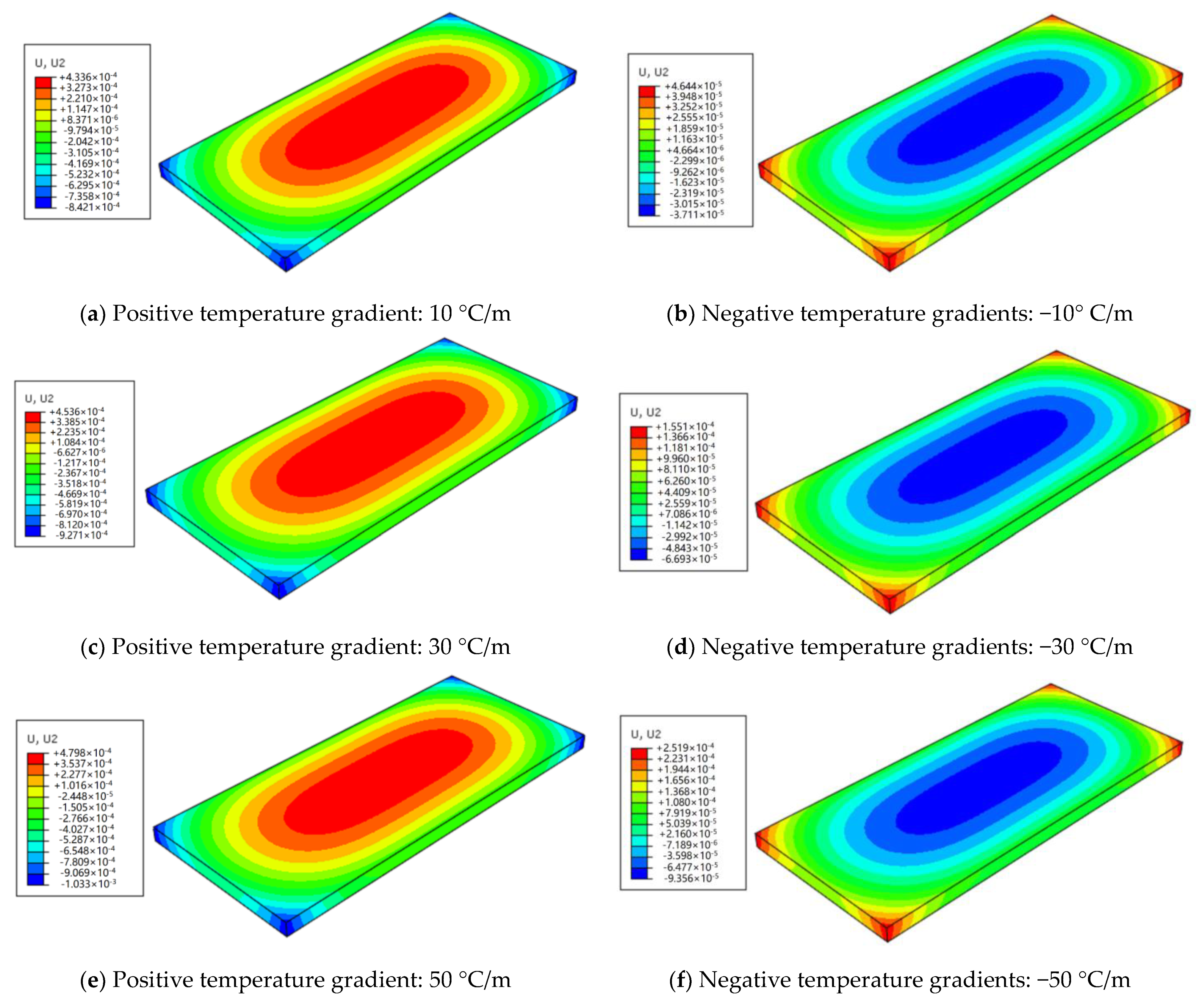
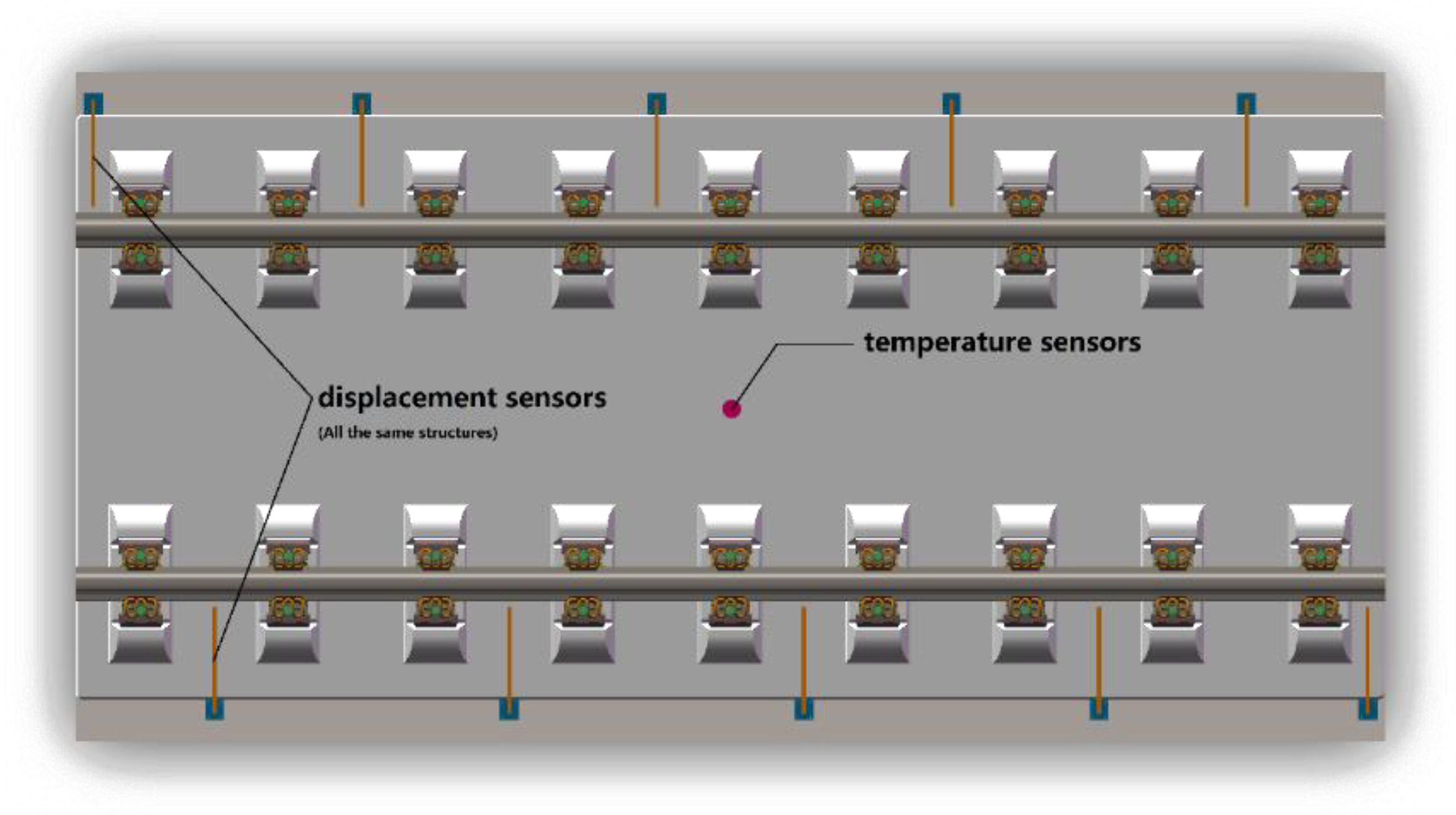


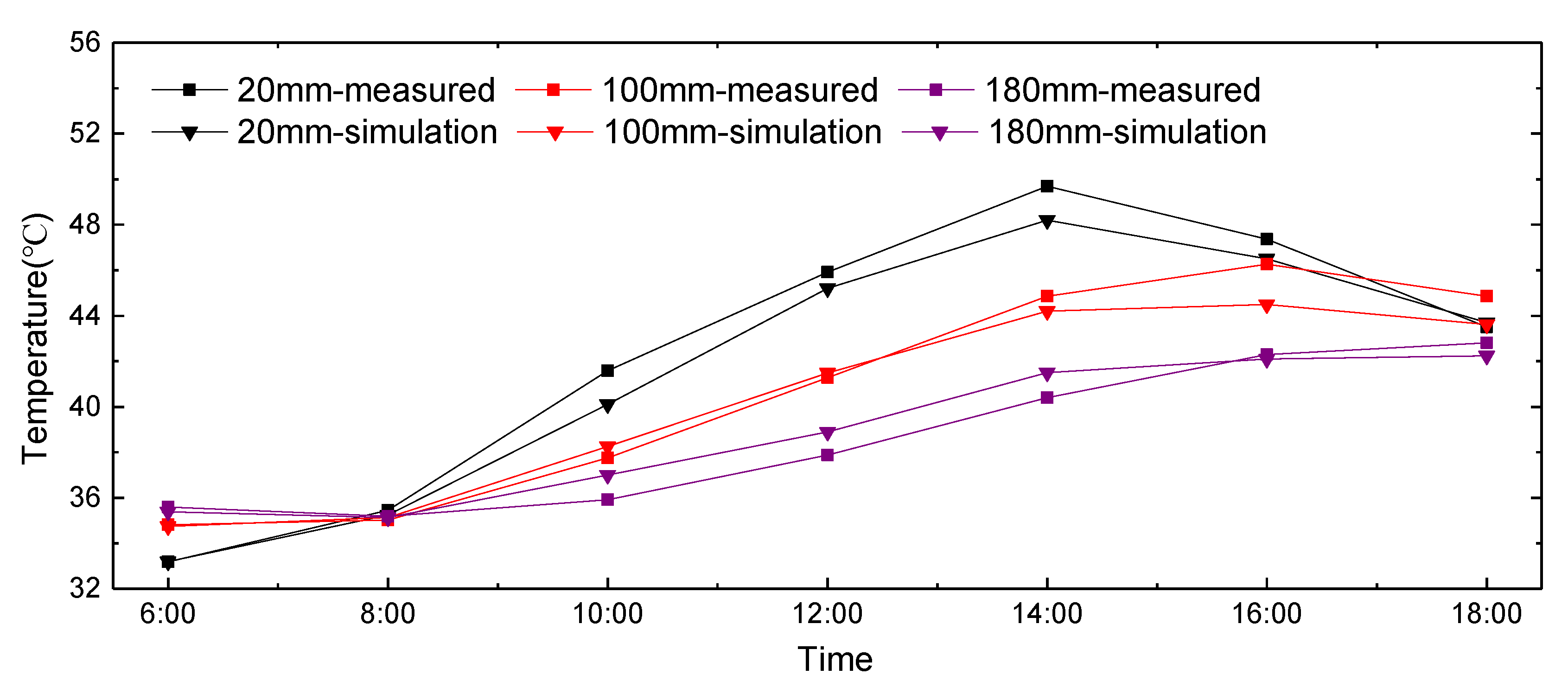

| Length (mm) | Width (mm) | Height (mm) | |
|---|---|---|---|
| Slab track | 5600 | 2500 | 210 |
| Self-compacting Concrete | 5600 | 2500 | 100 |
| Base plate | 5600 | 2900 | 200 |
| The Distance from Slab Track Surface(mm) | 6:00 (°C) | 8:00 (°C) | 10:00 (°C) | 12:00 (°C) | 14:00 (°C) | 16:00 (°C) | 18:00 (°C) |
|---|---|---|---|---|---|---|---|
| 0 | 32.424 | 35.28 | 40.696 | 46.601 | 49.475 | 46.725 | 43.606 |
| 10 | 32.802 | 35.26 | 40.404 | 45.97 | 48.887 | 46.655 | 43.778 |
| 20 | 33.141 | 35.242 | 40.122 | 45.366 | 48.314 | 46.545 | 43.91 |
| 30 | 33.442 | 35.225 | 39.852 | 44.79 | 47.757 | 46.396 | 44 |
| 40 | 33.709 | 35.209 | 39.592 | 44.242 | 47.216 | 46.213 | 44.052 |
| 50 | 33.945 | 35.195 | 39.343 | 43.721 | 46.692 | 45.999 | 44.067 |
| 60 | 34.153 | 35.182 | 39.105 | 43.226 | 46.183 | 45.76 | 44.05 |
| 70 | 34.337 | 35.17 | 38.878 | 42.757 | 45.691 | 45.5 | 44.002 |
| 80 | 34.498 | 35.159 | 38.661 | 42.312 | 45.216 | 45.222 | 43.927 |
| 90 | 34.64 | 35.149 | 38.454 | 41.891 | 44.756 | 44.93 | 43.828 |
| 100 | 34.765 | 35.141 | 38.258 | 41.494 | 44.313 | 44.627 | 43.706 |
| 110 | 34.876 | 35.134 | 38.071 | 41.118 | 43.886 | 44.317 | 43.565 |
| 120 | 34.973 | 35.129 | 37.894 | 40.763 | 43.474 | 44.002 | 43.408 |
| 130 | 35.06 | 35.124 | 37.726 | 40.429 | 43.079 | 43.685 | 43.236 |
| 140 | 35.137 | 35.121 | 37.567 | 40.115 | 42.699 | 43.367 | 43.051 |
| 150 | 35.206 | 35.118 | 37.418 | 39.819 | 42.335 | 43.051 | 42.857 |
| 160 | 35.269 | 35.117 | 37.277 | 39.541 | 41.985 | 42.739 | 42.654 |
| 170 | 35.325 | 35.117 | 37.144 | 39.281 | 41.651 | 42.432 | 42.445 |
| 180 | 35.376 | 35.119 | 37.02 | 39.036 | 41.332 | 42.13 | 42.231 |
| 190 | 35.422 | 35.121 | 36.903 | 38.807 | 41.027 | 41.836 | 42.015 |
| 200 | 35.465 | 35.124 | 36.794 | 38.593 | 40.735 | 41.55 | 41.796 |
| 210 | 35.505 | 35.129 | 36.692 | 38.392 | 40.458 | 41.273 | 41.578 |
| Material | Properties |
|---|---|
| Fail | Linear expansion coefficient: 1.2 × 10−5/°C Elastic modulus: 2.1 × 1011 pa Density: 7850 kg/m3 Poisson ratio: 0.3 |
| Fastener | Vertical stiffness: 50 kN/mm Transverse stiffness: 35 kN/mm Fastener spacing: 0.65 m |
| Slab track | Linear expansion coefficient: 1 × 10−5/°C Elastic modulus: 3.6 × 1010 pa Density: 2500 kg/m3 Poisson ratio: 0.2 |
| Self-compacting concrete (SCC) | Linear expansion coefficient: 1×10−5/°C Elastic modulus: 3.25 × 1010 pa Density: 2450 kg/m3 Poisson ratio: 0.2 |
| Base plate | Linear expansion coefficient: 1 × 10−5/°C Elastic modulus: 3.25 × 1010 pa Density: 2500 kg/m3 Poisson ratio: 0.2 |
| Displacement Variation in the Middle of Slab/mm | Displacement Variation of the Edge of the Slab/mm | ||
|---|---|---|---|
| Heating | 10 °C | 0.032 | 0.035 |
| 20 °C | 0.083 | 0.086 | |
| 30 °C | 0.134 | 0.137 | |
| 40 °C | 0.185 | 0.188 | |
| Cooling | 10 °C | −0.07 | −0.067 |
| 20 °C | −0.121 | −0.118 | |
| 30 °C | −0.172 | −0.169 | |
| 40 °C | −0.223 | −0.22 | |
| Displacement Variation in the Middle/mm | Displacement Variation of the Edge/mm | ||
|---|---|---|---|
| Positive temperature gradient | 10 °C/m | 0.428 | −0.781 |
| 30 °C/m | 0.453 | −0.873 | |
| 50 °C/m | 0.477 | −0.981 | |
| Negative temperature gradient | −10 °C/m | −0.035 | 0.0464 |
| −30 °C/m | −0.061 | 0.155 | |
| −50 °C/m | −0.085 | 0.252 | |
Publisher’s Note: MDPI stays neutral with regard to jurisdictional claims in published maps and institutional affiliations. |
© 2021 by the authors. Licensee MDPI, Basel, Switzerland. This article is an open access article distributed under the terms and conditions of the Creative Commons Attribution (CC BY) license (https://creativecommons.org/licenses/by/4.0/).
Share and Cite
Zhou, J.; Luo, Y.; Lv, G.; Xiong, Y. Simulation Study on Vertical Deformation of CRTS III Slab Track under Ambient Temperature and Its Upgrade to “Green Maintenance”. Appl. Sci. 2021, 11, 7830. https://doi.org/10.3390/app11177830
Zhou J, Luo Y, Lv G, Xiong Y. Simulation Study on Vertical Deformation of CRTS III Slab Track under Ambient Temperature and Its Upgrade to “Green Maintenance”. Applied Sciences. 2021; 11(17):7830. https://doi.org/10.3390/app11177830
Chicago/Turabian StyleZhou, Junzhao, Yanyun Luo, Guosheng Lv, and Yongliang Xiong. 2021. "Simulation Study on Vertical Deformation of CRTS III Slab Track under Ambient Temperature and Its Upgrade to “Green Maintenance”" Applied Sciences 11, no. 17: 7830. https://doi.org/10.3390/app11177830
APA StyleZhou, J., Luo, Y., Lv, G., & Xiong, Y. (2021). Simulation Study on Vertical Deformation of CRTS III Slab Track under Ambient Temperature and Its Upgrade to “Green Maintenance”. Applied Sciences, 11(17), 7830. https://doi.org/10.3390/app11177830






